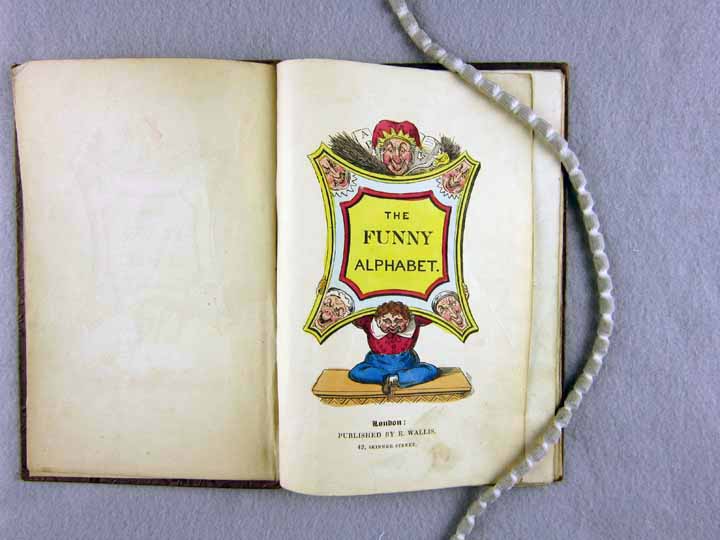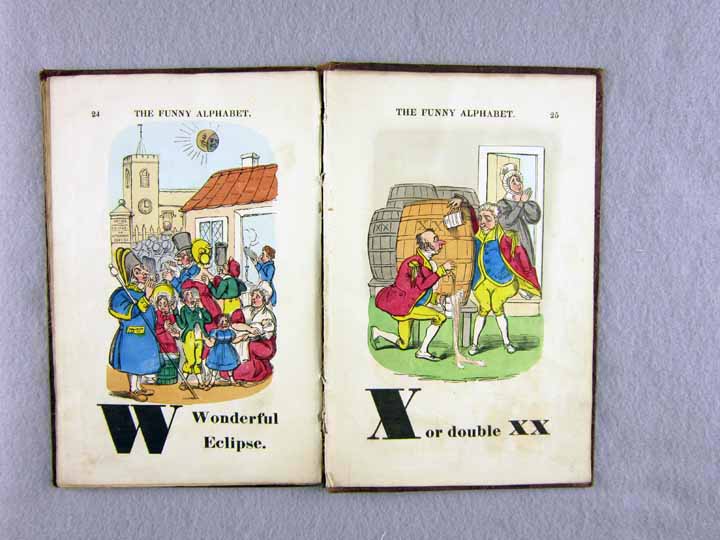

Alphabet books offer a vivid insight into the history of literacy and culture, as well as concepts of childhood. The Children's Book Collection at UCLA contains a rich array of these materials, some well-worn and much-used, some still bright and fresh. Each is a gem of print production and graphical imagery from another time and place. Though the history of alphabet books continues to the present, this exhibit focuses on the works in our collections published between 1700 and 1900, including horn books, primers, works of didacticism and seriousness, whimsy and play.
2. A Jumble ABC
3. A Little Pretty Pocket-Book
4. A New Lottery Book of Birds And Beasts
5. A Pretty Play-Thing for Children of All Denominations
8. ABC of Objects for Home And School
10. ABC with Pictures & Verses
12. Alphabet Et Instruction Pour Les Enfans
16. Dolly's ABC Book
17. Flora's ABC
18. Home ABC
22. Hornbook C. 1700
23. Large Letters for the Little Ones
24. Little ABC Book
25. Little People: An Alphabet
26. Martin's Nursery Battledoor
27. Mother Goose ABC
28. My Darling's ABC
29. Orbis Sensualium Pictus Quadrilinguis
30. People of All Nations: A Useful Toy for Girl Or Boy
31. Picture Alphabet
32. Pretty ABC
33. Railway ABC
34. Rusher's Reading Made Most Easy
38. The Alphabet of Old Friends
40. The Amusing Alphabet for Young Children Beginning To Read
42. The Child's Christian Education
45. The Easter Gift
47. The Favorite Alphabet for the Nursery
49. The Franklin Alphabet And Primer
51. The Golden ABC
55. The Moral And Entertaining Alphabet
57. The Old Testament Alphabet
59. The Picture Alphabet for Little Children
62. The Sunday ABC
63. The Union ABC
64. The Young Child's ABC, Or, First Book
65. Tom Thumb's Alphabet: Picture Baby-Books
67. Warne's Alphabet And Word Book: with Coloured Pictures
68. Wood's Royal Nursery Alphabet
Title The Funny Alphabet


Brief description Alphabet book of little vignettes of cartoonish children in Victorian era England. From the MARC record: 27 leaves of plates all color illustrated. Embossed floral pattern on cover. This has been attributed to Thackeray, but on what authority I have been unable to learn--Van Duzer, H.S. Thackeray. William Makepeace Thackeray 1811-1863. Ex libris Olive Percival bookplate. A white label, Thomas E. Stewart pasted on upper paste-down.
Full description Containing common alphabetical words and phrases, caricature-like vignettes of mischievous children accompany the pages of The Funny Alphabet. Possibly attributed to the early work of William Makepeace Thackeray, a British novelist who penned the satirical portrait of 19th century English society, Vanity Fair, this alphabet books is more "funny" than "alphabet." While traditional alphabet words like "A is for Apples" are found in the book, the scene depicts children getting caught trying to steal a bucket full of apples. The rest of the alphabet ensues with scenes of mischievous boys and girls playing the "Kettle Drum" and "Quarrelling with each other," and at the same time mocking authority figures. These comical scenes show that the daily life of childhood, as well as the cultural landscape of England in the 1830's.
Literacy The Funny Alphabet is not a book for beginning readers as can be seen clearly from the first few pages of the book, with multisyllabic words like "Butterfly for B" all the way to "Wonderful Eclipse for W." While even the youngest of tikes could laugh at the silly scenes depicting children attempting to trap a "wily Rabbit," the word itself is a bit more complex. The attitude is further demonstrated by scenes for the word "Zealous" which illustrate the politician Lord Humbug (whose identity we discern from an election poster) asking for the votes of townspeople. Not only would a child have to be literate to read the campaign sign in the illustration, they would have to be literate in political contexts to understand what a "zealous" politician looks like. In this way the book is geared more for older readers that could understand complex words and ideas.
Childhood The children depicted in The Funny Alphabet are actually ruddy-faced miniature adults. The children resemble their large counter-parts, but the children's actions are playful and devious. They appear to have no responsibilities other than horse-play (Hide and Seek, and Leap Frog are both phrases that appear) with one another. The well-dressed rascals are illustrated in both town and country life, similar to the ways of living experienced by the child owner of this book. Due to the higher production value and colorful drawings, the child probably came from some amount of wealth, and much like the children in the book, enjoyed a life of leisure.
Iconography The world portrayed in The Funny Alphabet includes elements from the country as well as the city. While illustrated leisure activities such as "F for fishing" and "I for ice skating" would be familiar to most children and adults today, other letters give a more in depth look into the cultural landscape of England in 1836.The "X stands for XX "which illustrates a vignette of two men getting drunk off ale maybe seem simple enough to understand as X was the symbol for an alcohol's potency, but on further inspection the woman dressed in puritanical garb stands off to the side in dismay. The 1830's in England were the height of the Temperance Movement and this scene, which is more New Yorker cartoon than reading literacy tool, would have been recognizable, and a bit of a hot topic to those abreast of the current politics. "V for Vanity" depicts a black man in fancy dress enamored with his own gaze in the mirror, while a white woman looks on and giggles. The 1830's also happened to be the time when the United Kingdom finally abolished slavery across the empire. A black man excited to be seen as an equal, as well as the mocking that comes with the latent racism of the time would be obvious and possibly amusing to informed readers.
Production With brown cloth over boards embossed with a floral pattern and blocked in gold, The Funny Alphabet would not have been a cheap book to produce. The colorful pouchoir illustrated designs would have taken time and skill to accomplish. Published by E. Wallis in London, the shop also was known for publishing poetry, as well as color prints and board games.
Publisher E. Wallis
Publication place London
Date 1836
UCLA Call Number CBC * PZ6 .F9653 1836
Repository UCLA Charles E. Young Research Library, Dept. of Special Collections
Dimensions 21 cm
Media and Materials Paper
Caption